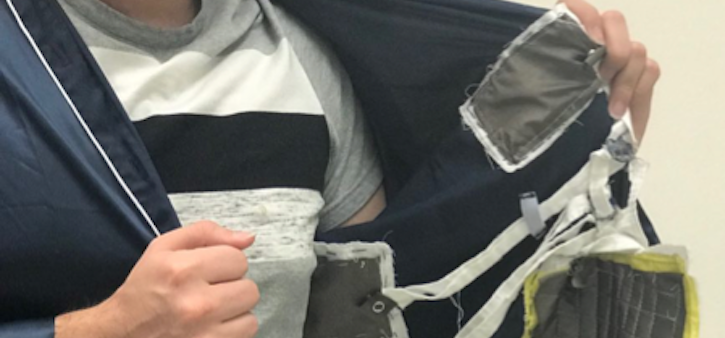Physiological-Sensing Textiles Could Lead to Sleep-Related Insights
The wearable sensors could contribute to the early diagnosis of multiple disorders.

Photo/Thumb have been modified. Courtesy of UMass Amherst/Andrew lab.
From smartwatches like Fitbit and the Apple Watch to sensors that can detect what’s in your sweat, the wearable device market is ripe for innovation in healthcare.
A new possible wearable, which scientists from the University of Massachusetts (UMass) at Amherst have dubbed “phyjamas,” has physiological-sensing textiles that can be woven or stitched into sleep garment to monitor an individual throughout the night.
The electronically active garments contain unobtrusive, portable devices to monitor heart rate and respiratory rhythm during sleep, among other things, the scientists reported.
“The data generated by fabric-based sensors have the potential to improve health and well-being and could possibly contribute to the early diagnosis of multiple disorders,” said Peter Reinhart, Ph.D., founding director of the Institute for Applied Life Sciences at UMass Amherst.
A team of scientists had to develop their own fabric-based sensor because it was difficult to get useful signals without changing the aesthetics or feel of the textile. Smart textiles generally refer to tightly worn clothing with sensors embedded in it to measure physiological and physical signals, said Trisha Andrew, Ph.D., associate professor in chemistry at UMass.
But that is not a solution for everyday clothing or sleepwear, Andrew added.
While sleepwear is loose, parts of the textile are still pressed against the body, said Deepak Ganesan, Ph.D., professor in the computer science department at UMass.
The pressure from certain parts of the body could facilitate the measurement of ballistic movements caused by heartbeats and breathing, which can be used to extract physiological variables.
Those signals could be unreliable, though, but signals from many sensors placed on different body parts could be combined to get a more accurate reading.
The scientists designed a new fabric-based pressure sensor for loose-fitting clothing and combined it with a triboelectric sensor which activates by a change in physical contact. The team of scientists also developed data analytics to fuse signals that took into account the quality of the signal coming from each location. These aspects allowed the scientists to detect physiological signals across different postures, the scientists reported.
To test the phyjamas, the scientists conducted two study.
In the first study, 21 participants between 22 and 38 years old wore an extra large phyjama shirt. The scientists recorded the output voltage in various stationary positions. The team of scientists collected data from a variety of postures for each participant, including six sleep postures and two stationary postures. To measure heart rate, the scientists used a three-channel electrocardiogram measurement on two wrists and an ankle. The scientists measured respiration with a pulsesensor.
In the second study, seven participants ranging between 30 and 70 years old took an hour-long nap wearing the phyjama to evaluate the performance of the wearable across different age groups.
Studies to test the phyjamas showed that the clothing can extract heartbeat peaks with high accuracy, breathing rate with less than one beat per minute error and perfectly predict sleep posture, the scientists noted.
“We expect that these advances can be particularly useful for monitoring elderly patients, many of whom suffer from sleep disorders,” Andrew said.
Current wearables are not good for the older population because those individuals forget to consistently wear the device and sleepwear is a normal part of their daily life, said Andrew.
“Your watch can’t tell you which position you sleep in and whether your sleep posture is affecting your sleep quality; our phyjama can,” Andrew concluded.
The scientists plan to further explore different directions of their wearable.
Get the best insights in digital health directly to your inbox.
Related
British NHS To Give Out Wearables For Diabetes Prevention
Wearable Device Monitors Fetal Heartbeat, Could Reduce Stillbirths
Wearable Device Could Help Patients Experiencing an Overdose
2 Commerce Drive
Cranbury, NJ 08512
All rights reserved.